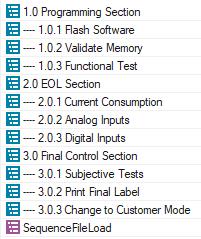An Insider's Guide to TestStand
Controlar develops and deploys automated production and validation test systems using TestStand.
But what is TestStand?
TestStand is a test management software framework developed by National Instruments (now NI). It is used in the field of automated test and measurement to create, manage, and execute automated test sequences or test sequences consisting of both automated and manual steps.
TestStand provides a secure platform for developing and deploying automated test systems, allowing users to:
- create and organize test sequences
- define test steps
- manage test data
- report test results

The platform provides a graphical user interface (GUI) for creating and editing test sequences, as well as a runtime engine for executing the tests.
Benefits of using TestStand
TestStand supports a wide range of test hardware and software, including instruments, devices, and interfaces from various vendors. It allows users to integrate and control these test resources within their test sequences. It also provides extensive customization options, allowing users to create custom test steps, develop custom user interfaces, and implement advanced test management features.
The primary benefits of using TestStand include:
Improved test development efficiency
Standardized test processes
Easier maintenance
Debugging of test systems
Consistent reporting of test results/ automatic report generation
Moreover, this software simplifies the automation of test systems with interactive workflows for hardware configuration, built-in debugging tools, and automatic report generation. Native tools to configure parallel testing and adapters to call test code written in other programming languages are also a plus.
TestStand Applications at Controlar
TestStand is commonly used in industries such as electronics manufacturing, automotive, aerospace, telecommunications, and medical devices, where automated testing is crucial for quality assurance and production efficiency.
At Controlar, we use TestStand for the development, debugging, and execution of test sequences. In order to include all the functionalities necessary to its structure, Controlar uses a variation of the TestStand’s original test steps.
The test-level functionality of these steps is exactly the same as the original, but some important features and settings are added to the functioning of the framework as a whole.
Considering the high number of systems we develop, often simultaneously, or for the same product family, it is useful to develop an abstract architecture for the different test system components.
This abstraction enhances the reuse of code and facilitates systems maintenance, especially when incorporated into large production lines integrating different stations.
Our Test Software Architecture
The architecture of Controlar’s test software seeks abstraction and the reuse of code by segmenting the different components of the test systems.
A test system has the final objective of executing a sequence that tests the different functionalities of the DUT using the hardware at its disposal. To achieve this goal, Controlar’s test system developers start by creating a library of sequences that comply with the DUT test specification documents.
This function library is created without prior knowledge of what equipment will be available in the final test system. In this way, functions are created abstractly. For example, if a function needs to configure the DUT supply to 13.5V, it is programmed to call a “Power Supply – Apply Voltage” function, regardless of whether the end station has a 2-channel source or a 1-channel source.
This function is part of another library of functions that implement the control of system equipment, such as power supplies, digital multimeters, etc. In the case of the previous example, in a 2-station scenario, one with a 2-channel power supply and the other with a 1-channel supply, the function “Power Supply – Apply Voltage” would be available in the function library of both stations, with different content. This content would reflect the difference between the sources. In this example, the specification library would only be developed once and reused at both stations, while the equipment libraries would be developed independently.
This abstraction logic is applied to the different software components of the system, accelerating the development of several test systems simultaneously and facilitating their updating when they go into production.




Learn how we develop an automated test system using TestStand
To develop automated validation or production test systems with TestStand, we follow these general steps:
Once we have validated and verified the test system, we may need to deploy it to the target production environment, ensuring proper hardware setup, software installation, and system calibration.
It is also necessary to maintain the test system by periodically reviewing and updating the test sequences as needed. Controlar facilitates the update of the system by the customer to accommodate changes in hardware, software, or test requirements that meet the necessary requirements.
Naturally, these specific steps may vary depending on the requirements and the complexity of the test system.





